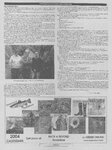| OCR Text |
Show THE ZEPHYR/OCTOBER-NOVEMBER 2004 THE REAWERSKESPOND SUPPORTS STILES ROAD CONTROLLING TAMARISK THROUGH BEETLES Hi, RULES Hello Regarding Stile's commentary on the narrow/curve dawdler who would SPEED up on the straightaways ... I recently had a similar experience driving over Red Mountain Pass (Ouray /Silverton). I had summitted, so to speak, in my 4-cylinder Honda and immediately fell in behind some 'dawdler' (my moniker gradually grew, like the downhill snowball, in vile-epithet layering) going the speed limit -- which is about 10 - 15 MPH. Now, I don't consider myself needlessly careless nor excessively impatient, but can safely cruise through the 'narrows' at an average 20 MPH plus. Like Stiles and the straightaway runaway ne’erthe-less curving dawdling IDIOT, this vehicle would SPEED UP at each ‘passable’ stretch. My Honda could NOT begin to match nor accelerate to the speeds needed to pass during the straight stretches -- and, sigh, the identical scenario would play out at each subsequent section of curves. Might have been the same dawdler Stiles encountered over Soldier Summit. Tired, but one of these years ... Farley Phitt Crystal City, Colorado LLOYD PIERSON... VETERAN ARCHAEOLOGIST/CYNIC? Dear Jim, I hate to burst your romantic bubble and story about the brave Waldo Wilcox keeping his secret of archaeological treasures from the greedy and avarice pot-robbing vandals for over 50 years. First of all, archaeologists have known about the Fremont culture in Range Creek for a long time. One even ran a small dig there back in the 1930s. Secondly the BLM was aware of the values there as they took me into Range Creek some 35 years ago when I was working for them as an archaeologist. Frankly, as an old Chaco hand, I was not all that impressed, although I admit to spending but a short time there. Lastly it was my impression that the Wilcox family sealed off the canyon, like many ranchers did, by homesteading a piece of ground that went from canyon wall to canyon wall. That way they controlled much more of the land than they owned. Even the BLM had to ask for a key to the fence gate so they could get to their property further down the canyon. The impression I got was that the Wilcoxes wanted to . keep out hunters and rustlers. The only road to the ranch came up through Sunnyside, a small mining community but one hungry at times for buckskin and elk. ; The canyon is still accessible from the Green River. This is not to take away from the fact that the Wilcoxes did protect the antiquities, but only incidentally. The recent furor and publicity poor Waldo got is due to the romance that archaeology still holds for the public, a slow day in the newsroom, an archaeologist bent on getting his or her name in the paper and a bunch of eager media people who are always willing to take the free guided trip out into the great out of doors so they can get away from the office. I am willing to bet that Waldo loved seeing himself on TV. The people they are going to have to watch about potrobbing are the hikers and the river runners, the only ones presently with access to the canyon. I read a recent article in your journal Zephyr by Julie Cozby regarding tamarisk control, and wanted to check in on a point that was raised and dismissed, unfortunately. Julie said that the thought of beetles eating the tamarisk ‘scares the hell out of me’. Since I've been working on the tamarisk biocontrol research for several years, I'd like to respond to that and maybe set the record straight. I got into the tamarisk control business because I've been a river ecologist for the last 25 years (Oregon, Calif., Arizona and Nevada; also doing riparian restoration in over-grazed meadows) and have seen more and more areas being taken over by exotics, with subsequent reduction in wildlife use and other impacts, so I figured I should change directions and get in to the exotics control end of things. We've been working with this beetle for many years, and have been able to show thatit's extremely specific to only feeding on tamarisk and nothing else in the wild (or crops either), and it simply dies when it runs out of tamarisk to eat. We've had great success with the release in northern Nevada, where the beetle (Diorhabda elongata) has In the meantime, we've seen huge increases in the use of this habitat by birds and small mammals, going after the beetles and finding the fuel needed for migration that was simply not available in the tamarisk stands before the beetle was introduced. Thus, during the interim period when the plants are gradually dying back and the natives are re-establishing (native willows and cottonwoods are present in all of our sites, so we know they can grow in these conditions still), the beetle releases have provided a huge enhancement in resource availability for wildlife. I don't know why someone would be scared as hell by this, but I suspect that more information would reduce the fear factor, just as it would when people find out just how morally bankrupt the Bush Administration is by trying to scare people into killing people in the name of anti-terrorism. We also have a release site there in Utah, in the Sevier R. system where there is a huge need for restoring the system that has been devastated by tamarisk invasion. I am glad to answer any questions that you and Julie might have about the program or about tamarisk in general; or russian olive too, and there is, indeed, a biocontrol program being developed for this invader as well, but it has been hard to convince funders to support the program, and public fears about biocontrol plays a big role in this. It's frustrating when one is confronted by public animosity something that many of us have dedicated much of our lives to. and fear regarding Thanks for hearing me out. Tom Dudle Assoc. Research Prof. Natural Resource & Environmental Science University of Nevada, Reno Continued on next page... 2 PAGE29 Lloyd Pierson Moab, UT Editor's Note: Good Grief Lloyd! And I thought I was cynical. You're getting downright grumpy in your late middle age....JS VISION. INTEGRITY CAPER BEING E REEEEG| JOETTE LANGIANESE FOR GRAND COUNTY COUNCIL DISTRICT #5 ON NOVEMBER2 - APROVEN LEADER WHO GETS THEJOB DONE PAID POLITICALAD established throughout the lower portion of the Humboldt River and Sink, but this plant recovers well so we think it will generally take three or more years, if ever, to kill plants. Many if not most will remain alive, but reduced in their invasive nature with reduced impacts in these riparian ecosystems. |


































